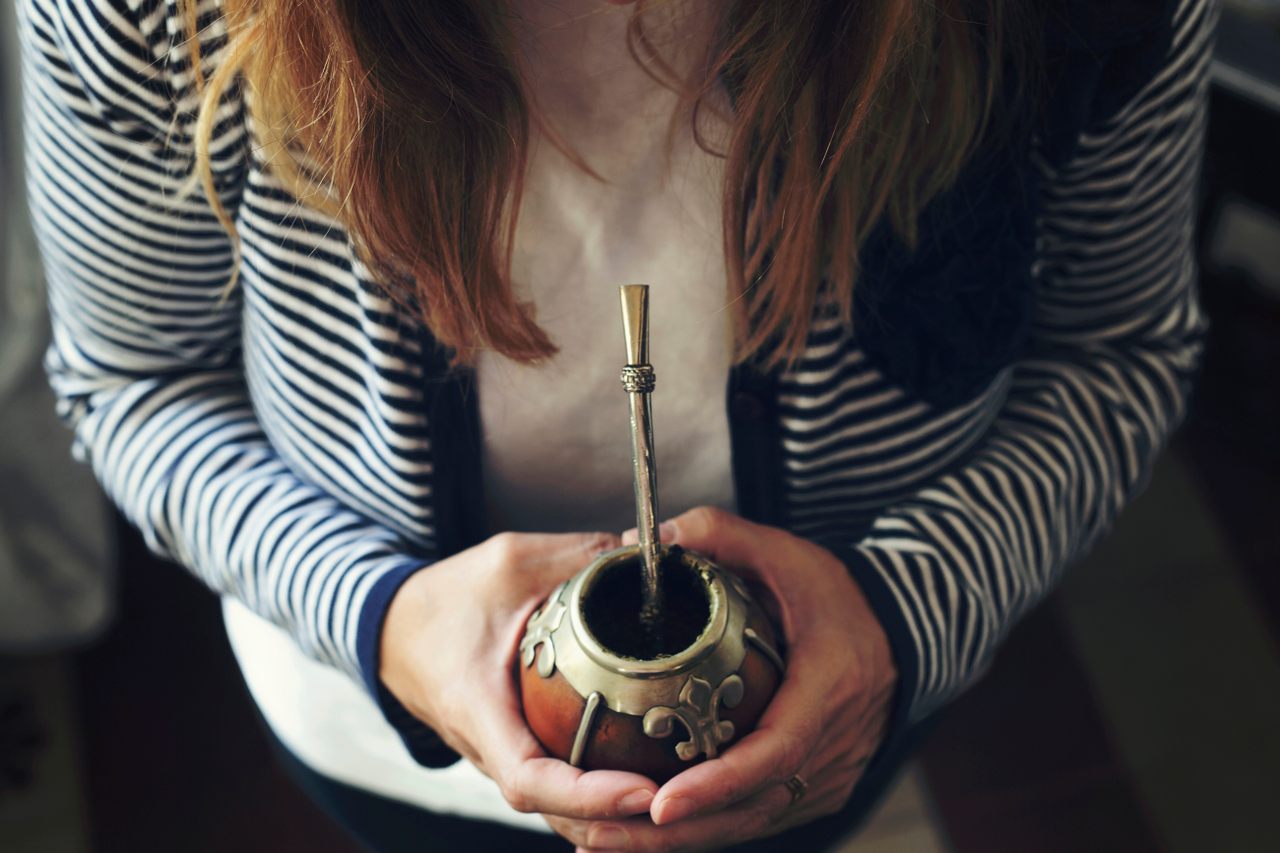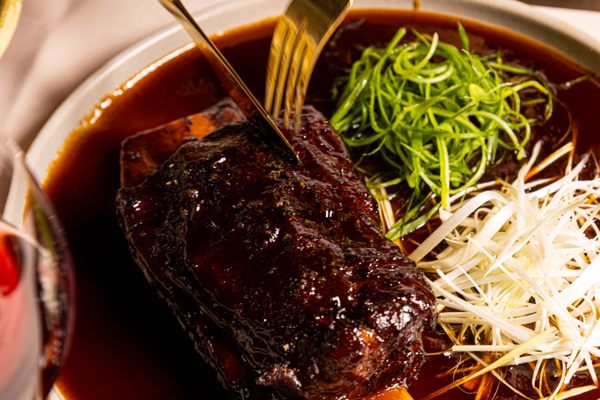How the Pandemic Transformed Argentina’s Yerba Mate Traditions
Communal cups and shared straws are losing ground to solo sipping.
Years ago, in a bombed-out museum in La Plata, Argentina, I was offered yerba mate by a complete stranger. A winter chill whistled through the front wall left exposed by a tank, whilst a woman continued to warm water into her mate and offer it to those in the room. The hot burst of bitter liquid drew an invisible line connecting everyone in that gray, somber space.
Mate is a caffeinated, tea-like infusion made from the dried leaves of the yerba mate plant. Often drunk hot, mate has an intense, earthy taste—think grass, smoke, and soil. The practice of drinking from a shared straw in ronda (in a circle) has been bringing people in Argentina together for centuries.
First introduced to the Jesuits by the indigenous Guaraní people during the colonial period, mate has been part of Argentina’s national identity from the very beginning. “Drinking mate marked the difference between the European and criollo, or local, way of living,” says Claudia Bosoni, anthropologist and adjunct professor at the Universidad del Salvador in Buenos Aires. As a country largely built by immigrants, Argentina has historically been a complex country to unite.
But mate brought people together, both physically and spiritually. “It was a local custom that most criollos drank, no matter where they came from,” explains Bosoni.

Today, according to the Instituto Nacional de la Yerba Mate, over 90% of Argentine households have yerba mate in the pantry. “Our identity can be very black and white,” says Bosoni. “It is always Boca versus River [Argentine football teams] or Peronism versus Anti-Peronism [political leanings] but mate goes above all of this. It is something that everybody drinks.”
Mate is more than tea. It is an invitation to share in that great Argentine pastime of conversation, and a ronda session may last for an hour or two. “We usually drink mate with friends and family in the afternoon, between four and seven,” says Pedro Jaureguiberry, an Argentine engineer now living in Brazil. “We use that pause to talk, to listen and to really connect with the people you are drinking mate with. It is not like drinking beer at a bar. When you drink mate, it is more profound.”
While mate is also drunk in Southern Brazil, Paraguay, and Uruguay, it is solely in Argentina where the communal tradition of drinking in ronda has stuck. “What I always loved about mate was the ritual that surrounds it,” says Natalia Cicala, a human resources manager who lives in Buenos Aires. “Being a part of the ronda gives you a sense of belonging, you feel part of a group. It is all about friendship and camaraderie for me.”

But sharing one mate (the cup or gourd—usually made from a calabash) and one bombilla (straw) in ronda is obviously a practice not conducive to minimizing the spread of infectious disease during a global pandemic.
Prior to the appearance of COVID-19, sharing mate was a point of pride, generosity, and inclusion. “When I was doing my errands—going to the supermarket or the fruit and vegetable store—if someone asked me the time or I started to talk to someone in the queue, I would offer them a mate,” says Camila Ciampi, a French teacher and UX/content designer who lives in Rio Grande. “You really didn’t question the fact of sharing it, even with people you just met,” adds Cicala.
But in the throes of the pandemic sharing mate became potentially deadly. “For those of us, like me, who enjoyed the ronda and ritual of drinking mate with friends, family, colleagues, and fellow students, we lost a lot during the pandemic. It was definitely frowned upon to share a mate; it was scary to share,” explains Cicala.
Today, sharing mate looks different. A recent study from the Instituto de Estudios Sociales at the Universidad Nacional de Entre Ríos reports that just 9.5% of Argentines are now willing to share mate with anyone who walks by.
“I think it is too soon to measure what has changed but it has definitely affected the way we relate to strangers or how we start a relationship,” says Bosoni. “In our inner circle, we are still drinking mate in a very similar way, but it is something that you are no longer doing with strangers.”

“Mate is a way of engaging and showing trust, and showing that you like the other person. You are drinking from the same straw, so you need trust,” explains Jaureguiberry. But what happens when that trust is lost? What becomes of the stranger who is no longer invited to take part? “The pandemic was a breaking point in the way that we relate with each other, not just with strangers. Now, we need to build new ways to connect,” says Bosoni.
Argentina’s food culture emphasizes hosting, ritual, and performance. In a mate ronda, it is the cebador or cebadora who prepares the yerba mate and pours the water, offering a serving to each present and to whom the cup always returns. It is a role of responsibility and honor. In fact, the closest translation for cebar in English is “nourish” or “feed.”
Argentinians continue to drink in ronda, though it is now more likely that each person will bring their own cup to the circle. But contrary to what might appear obvious, the cebador has not disappeared. Now, everyone is their own cebador.
“Now that everyone has their own mate in the ronda, I think it becomes more democratic, instead of something somewhat tyrannical,” explains Bosoni. Traditionally, the cebador was always in charge of the pace. Pre-pandemic, it was common to hear the cebador snap “The bombilla isn’t a microphone!” The message was clear; stop talking, start drinking.

But for some, the loss of the communal cup has been too much. Cicala, a self-proclaimed matera (a big mate fan), has stopped drinking mate altogether. “I just couldn’t drink it alone. Gradually I have lost my taste for it, since it just isn’t the same,” she says. For Argentines like Cicala, the joy of mate is the sense of reciprocity, the dialogue it generates, and what is shared.
Despite some Argentines abandoning the custom, there are plenty of next-generation cebadores who have taken to walking the streets, with a personal thermos of hot water and mate in hand. Previously, this would’ve been enough for ridicule. Drinking mate alone, like the Uruguayans? It sounds like the basis of many an Argentine joke. What? Don’t they have any friends?
With the shift away from drinking in ronda, due to the lingering hesitance to share, yerba mate sales are through the roof as drinkers secure their own supplies. And despite hyperinflation and rising yerba mate prices due to a recent drought, Argentina is in the midst of a mate boom. At the moment, many young cebadores aspire to own a green Stanley thermos, a status symbol representing wealth and the ability to travel.
However, there are still those who mourn the communal drinking experience. Ciampi has adapted to drinking her mate alone in the mornings. “But the grace of drinking mate isn’t drinking one after the other, alone, this kind of rhythm,” she says. “The lovely thing is to drink with another, to sip and then rest.”
“When you drink alone, something always pops up, and then you leave it for 10 minutes and the yerba gets cold,” she continues. ”But when you drink it with someone else, it maintains the temperature of the yerba. It is almost as if mate needs a community to sustain the warmth.”
Gastro Obscura covers the world’s most wondrous food and drink.
Sign up for our regular newsletter.


























Follow us on Twitter to get the latest on the world's hidden wonders.
Like us on Facebook to get the latest on the world's hidden wonders.
Follow us on Twitter Like us on Facebook